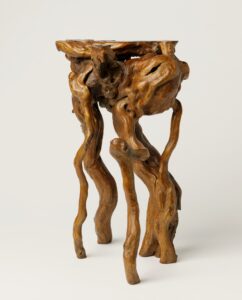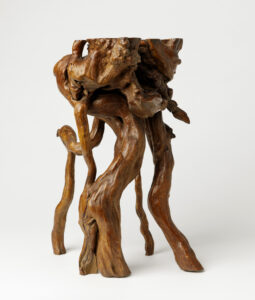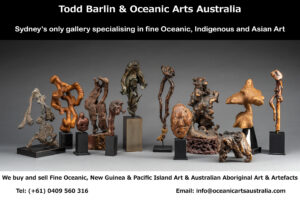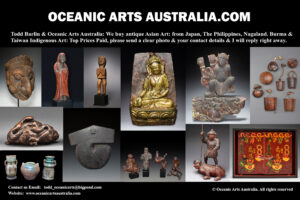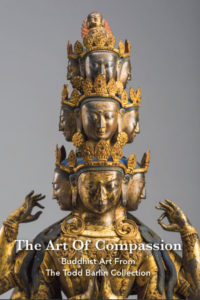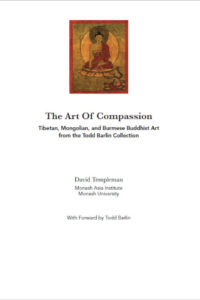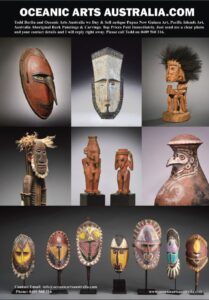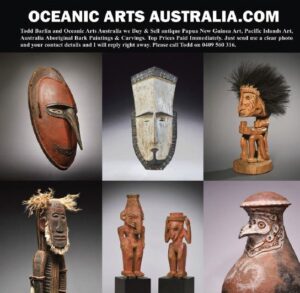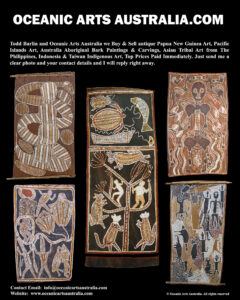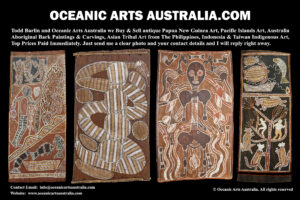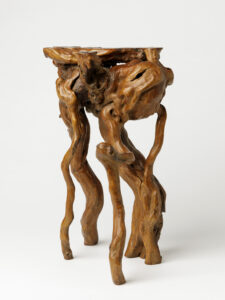A Superb Old Japanese Natural Form Stand or Kadai Edo Period 19th Century
| Collection No. | TA-549 |
|---|---|
| Size | Height 38cm |
A Superb Old Japanese Natural Form Burl Wood Stand for Ikebana Flowers
This beautiful and mysterious object is a root-wood Kadai Stand or table is from Japan was made in the 19th Century. A Kadai is a Japanese stand or table used for putting Ikebana Flower arrangements or Okimono created specifically for display, and often used in tea ceremonies
The Japanese aesthetic of using natural forms in wood with minimal additions by the artist is one of the most beautiful objects in my collection. No matter which side you look at, there is always something new in the form, like when looking at clouds in the sky.
This is a Wabi-Sabi Okimono sculpture that was probably used in tea ceremonies.
In Zen philosophy, there are seven aesthetic principles for achieving Wabi-Sabi as listed below;
Fukinsei (不均斉): asymmetry, irregularity;
Kanso (簡素): simplicity;
Koko (考古): basic, weathered;
Shizen (自然): without pretence, natural;
Yugen (幽玄): subtly profound grace, not obvious;
Datsuzoku (脱俗): unbounded by convention, free;
Tree Root and Bamboo carving is a traditional art in Japan, and has a long history among the Folk-Art carvers and practitioners specifically focused on supporting Ikebana, displays of precious artwork, and objects that have a practical utility such as Calligraphy brushes, brush pots and washers, containers, slabs, as well as the production of pieces of simply aesthetic value.
Three-dimensional objects such as miniature mountains are valued by Buddhists throughout Japan, for which many pieces cannot be named easily, and therefore are referred to as “nameless” root carvings. Integrating ingenuity and craftiness, they all focused on the unique features of ingenuous techniques exhibited in the creation of beautiful containers and display furniture.
It all began with wood craftsmen and the desire to support the formal traditions of Japan such as the tea ceremony and religious ceremonies with objects created out of crude tree roots and bamboo element. These works thoroughly exhibit the enthusiasm of number of root carvers and Buddhist Monks in service throughout the Japanese development of carving that gained unique artistic appeal and won the hearts of people throughout Japan and around the world.
The creation of root carvings included many steps, including root selection, conception, processing, and lacquering all based on the important principle of making useful the natural tree and elements of the tree root. Bamboo roots are different in their forms, either in size or in structure. Each root is suitable for carving according to its natural structure. The Japanese claim “three-tenths of the work is done by humans, seven-tenths are determined by nature,” attaching great importance to making use of the traits of the natural root, such as the fibres, holes, knurls, veins, colour and lustre. With a motif in mind, the creator should employ different carving techniques on roots of different shapes; the ultimate purpose is to integrate the unique beauty of the natural root with the cunning beauty attained by carving. Since root carving is largely done by making use of the natural beauty, the opus is of an integrated style.
The second principle is highlighting the composition. There are quite many modes of composition in root carving, and the one most common is the “triangle setup”, which is usually employed in sculpture. Other geometrical shapes, such as circles, ellipses and lozenges, are also used to further composition. Next comes the principle of expressing the mentality and sentiment of the creator. Root carving derives from real life, and it surpasses and regresses to it. However, it is by no means a replication of real life; rather, the creator reveals his inner feelings by making use of the characteristics of the natural root.
Finally comes the principle of seeking singularity and pursuing beauty. No art form is detached from the material used, and root carving is no exception. Root artists have to refer to nature for materials, and their pursuit of singularity and beauty lies in the process of selecting roots as well as in the conception process. They have to find out and collect roots of various odd shapes, which give them creative inspiration. Only after obtaining a uniquely shaped root can the artist apply his or her wisdom, imagination and originality to creative bamboo and root carving.
Provenance: The Todd Barlin Collection of Japanese Art & Objects & Asian Art & Objects. Please look at my collection of Japanese Inro & Smoking Pouches & other Japanese art objects on my website link below
See more Fine Japanese Art in Japanese Art Gallery
See my new EXHIBITIONS GALLERY showing the Museums and Art Galleries Exhibitions that I provided artworks for over the past 40 years. There is the link to the article about my artworks published in the prestigious Louvre Magazine in 1996
I have artwork for Museums and art Galleries but also for collectors at every stage of their collecting. I want to encourage people to explore the fine art of New Guinea & West Papua and the Pacific Islands and to be able to see and touch the artworks in a relaxed and friendly manner in my Sydney Gallery. I would like to invite you to visit my gallery and see the artworks in person and also look at my website www.oceanicartsaustralia.com where there are many Galleries & Sub Galleries to explore.
My Gallery of nearly 40 years is the last physical gallery in Sydney that specializes in New Guinea and Oceanic Art. Sydney is very close to New Guinea & the Pacific Islands where all of these amazing artworks came from, Australia’s closest neighbours.
To see many more rare items and the finest masterpieces, please make an appointment with us to visit the gallery.
For all inquiries, please contact us

